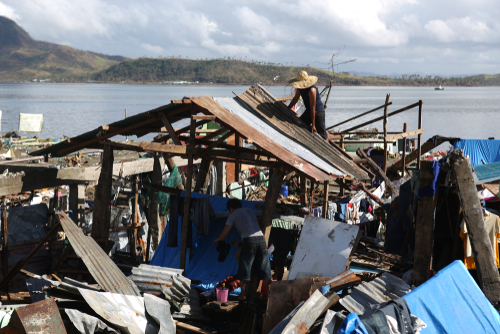Typhoon Mangkhut: Deadly typhoon lands in south China
Typhoon Mangkhut is lashing China’s most populous province, bringing winds of up to 100 mph (162 kph).
Guangdong is on its highest alert for the storm, which also hit Hong Kong, where it swayed skyscrapers and blew out windows.
The death toll from the Philippines has now risen to at least 59. Most died in landslides caused by heavy rain.
Mangkhut, considered the strongest storm of 2018, ploughed through the northern Philippines on Saturday.
What’s the impact in China?
Typhoon Mangkhut made landfall on the Chinese coast near Jiangmen city on Sunday afternoon local time, state media reported.
- In pictures: Deadly typhoon hits China
More than 2.45 million people have been relocated, and authorities there issued their highest warning level, a red alert.
In Hong Kong, authorities also issued their maximum alert, with residents warned to stay indoors to avoid flying debris. Winds there reportedly reached more than 110 mph (177 kph).
Officials put the number of injured at more than 200 but the territory avoided the worst of the storm.
Water levels surged by almost 3.5 m (12 ft) in places and live fish were washed on to the streets.
Most shops and public services were shut, and more than 800 flights have been cancelled at Hong Kong International Airport – affecting more than 100,000 passengers.
Not everyone paid attention to the warnings, though. “I went running this morning. I love fresh air and there’s no one on the streets, no cars. On normal days we can’t see this,” Hong Kong resident Hao Chen told the AFP news agency.
In neighbouring Macau, for the first time in its history the territory’s famous casinos were ordered to close.
Mangkhut is expected to weaken into a tropical depression by Tuesday as it moves inland.
How badly has the Philippines been hit?
Most of the deaths in the Philippines were caused by landslides in the Cordillera and Nueva Vizcaya regions, officials say.
Among the dead are a baby and a toddler. Blocked roads and downed communications lines mean reports are still coming in.
One of the worst incidents was in Itogon municipality, where accommodation for miners was crushed by a large landslide, killing at least 26, according to police. Eight more people are missing there.
Officials say that two first responders reported on Saturday to have been killed in a landslide in Cordillera province have been accounted for.
The BBC’s Howard Johnson travelled 80km (50 miles) from the city of Tuguegarao to Aparri on the northern coast.
He describes a trail of destruction along the route – forests ripped to shreds, electricity poles felled and crops eradicated.
There is also concern over the economic cost of the typhoon, which has caused extensive damage to farmland in Cagayan, a key agricultural province.
Francis Tolentino, a political adviser to President Rodrigo Duterte, told the BBC that he estimated only a fifth of produce there had been harvested in advance – threatening staples like rice and corn.
Preparation and evacuation procedures have improved since Super Typhoon Haiyan in 2013 which killed more than 7,000 people.
Warnings were issued, travel was restricted, schools shut and the army was put on standby in advance.

